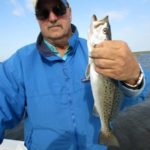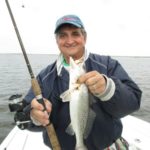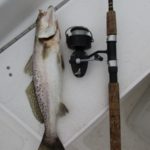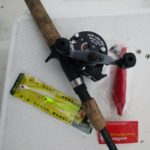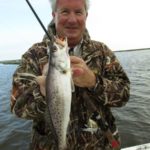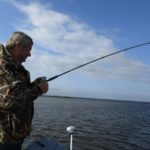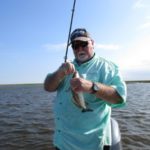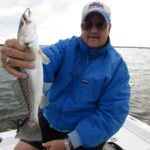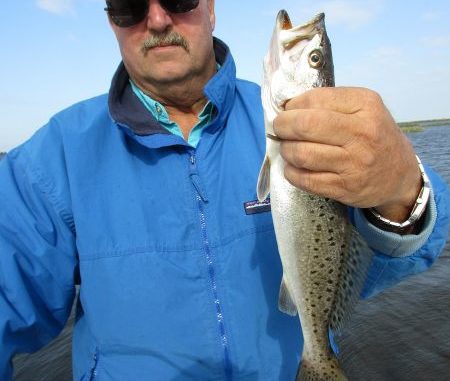
Anglers today have the latest, greatest gear. But will the old equipment and tackle from decades past still catch trout?
My plan seemed simple enough: I wanted to fish with some old gear to see if it’d still function and produce the way I remembered.
By “old gear” I don’t mean ancient 100-year-old stuff but the stuff I grew up with. The old Mitchell 300s spun with monofilament line and shad rigs.
That’s the stuff we fished with in the Delacroix waters when I was just a teenager.
My cousin Brian Graves and I were barely old enough to drive when we’d haul his 14-foot skiff down to Delacroix Island. Back then you could launch at Reggio or at Rudy’s or Melerine’s or Richard Campo’s or even at the End of the World.
And we took every opportunity we could to do so.
Propelled by a 40-horsepower Johnson, Little Lake, Grand Lake, Alligator Pass, Lake Batola and on out to Four Horse Lake was our territory — and we slung many a trout and redfish aboard that little skiff.
On more adventurous days we’d even poke our nose into Lake Campo if the winds were calm, and I don’t remember ever getting skunked.
Now, one of the things older folks do is reminisce, and I think we tend to remember the old days through rose-colored glasses, perhaps remembering them as being better than they actually were.
So my first order of business was to reacquire some of that older gear.
A quick search on eBay and a couple of online purchases later, and I was once again the owner of some old Mitchell 300s in good working order.
H&H Lures still distributes the old Speckline Shad rigs, so I picked up a few pair at Puglia’s Sporting Goods in Metairie, along with a few of the old Boone’s red-and-white shad rig floats I used to use.
I figured I was ready to kick some fish butt, old-school style.
Instead, the weather kicked my butt, forcing every trip I scheduled to cancel until my deadline had passed.
As a last-gasp hope, I asked a couple of old friends — old farts — to take me fishing old-school style on a day of far-from-ideal conditions.
They agreed, and that’s how I wound up at Capt. Ron “Ahab” Broadus’ dock, climbing aboard with Capt. Mike Wittich and an old buddy they brought along, Joel Weathers.
So we were four old farts, hoping for some old-school success on a gray and windy day.
We were in Wittich’s 24-foot Skeeter Bay, since Broadus had just ripped the lower unit off his boat on a submerged obstruction in the Pencil Canal.
Wittich pointed the bow toward Grand Lake and then through Orange Bayou as we made our way into Oak River and the Pointe Fienne area, where he’d caught some nice trout before the weather turned ugly.
“The trout haven’t schooled up in any significant numbers yet, so we’ve been moving around a good bit, picking up a few at each spot,” Wittich explained, as he slowed the boat near a point in about 4 feet of water. “Three or four here, half a dozen there: Just move and repeat until you put together a nice box of fish.”
The water was far from pretty, with a brownish stain to it. But water clarity was enough to make it fishable.
I took out one of my old Mitchell rigs loaded with a brand-new set of shad rigs and tried to hand off the other one — but found no takers.
The old farts preferred to fish with their newfangled gear and fancy-colored plastics.
Undeterred, I made a long cast with the old gear and impressed myself with the distance it traveled. I fan-casted all around the boat, as did the rest of the crew, but none of us attracted a strike with our artificial baits.
Then Wittich went real old school and tried live shrimp under a cork and caught a nice trout.
It’d be the first of many to come aboard that morning.
The rest of the gang switched gears and fished live stuff, while I stuck with the shad rigs as long as I could hold out.
But watching them sling hefty trout over the gunnel while I got nary a nibble eventually wore down my reluctance and I switched to live shrimp, also.
But I fished it on a 45-year-old Mitchell 300.
And the old reel worked flawlessly. It whirred as I reeled in, the noise reminding me of an old handle-cranked pencil sharpener on a schoolroom wall, but it performed like it was supposed to and I started swinging some trout aboard, too.
That spot was good for eight to 10 fish before it played out, and Wittich moved us down the shoreline to another prominent point.’
The sky was gray and overcast, and the air had a surprising chill to it for so late in the season. The wind was roaring at our back, enabling me to cast an incredible distance with the old gear.
But the old farts were showing off, casting even farther with their newfangled stuff.
Over the course of the morning, I kept trying the shad rigs but these fish were finicky, snubbing their noses at all but the live shrimp.
Broadus said it’s not unusual for trout to snub plastics this month because they feed heavily on live shrimp while gearing up for their migration to the outside waters and spawning season.
“But sometimes the trout will slam plastics very aggressively this month, so it’s worth trying your plastics under a cork or tight-lined, shrimp imitation lures and topwaters early or late,” he said. “But I suggest you always have some live shrimp onboard if you can get it, because on some days that’s about all they’ll hit.
“But if you get them started hitting the live stuff, then one or two guys can switch to plastic and they’ll hit it. But somebody will probably have to keep some live stuff in the water to keep the fish around.”
Weathers caught the biggest fish of the day — a hefty 21-inch trout — and let another the same size or larger shake off the hook just as he tried lifting it into the boat.
He hooked both on a big live shrimp.
We were moving to yet another spot when Broadus saw seagulls diving over open water in the bay we were crossing right next to Oak River, so we chased them.
I knew my shad rigs would produce under the birds, and they did.
But all the trout I caught were undersized.
Small trout are typical under the birds in the spring, but Wittich did put a few keepers in the boat on some chartreuse-colored newfangled plastic before the birds played out and we moved again.
This time he parked us in shallow water near a ledge where the depth dropped to 6 to 8 feet deep. Wittich said trout like to hang on the ledge and pick off bait sweeping by.
The plan was to cast a bait on a 3/8-ounce jighead without a cork where it was shallow and let the current drag it down the ledge to the hungry trout.
Demonstrating the tactic, Wittich made a cast with his fancy Shimano Chronarch and immediately caught a nice trout.
I was determined to do the same. But I wanted to kick it old school.
I’d also bought a 40-year-old Lew’s Speed Casting reel on eBay in near-mint condition. The old teardrop-shaped reel worked great, and was very smooth both casting and retrieving.
But I was handicapped by a shorter rod and couldn’t match the distance Wittich got with his fancy stuff.
But I did catch a nice trout on about my third cast, and if it’s a thrill to catch a trout anytime it’s even more so when you manage to relive the thrills of the old days.
Broadus said that if you intend to fish the Delacroix area this month, plan to make the run to the big fringe bays.
“The winter pattern is over, and the short hops where we caught fish near the docks are done for the year,” he explained. “You might find a few stragglers inside, but most of the action is happening right now in the big outside bays.
“We’re picking off some fish today in the intermediate bays, but they are clearly moving steadily toward the bigger bays on the outside. We’re only fishing in here today because the winds are too brutal to go farther out.
“But in May, you’ll want to fish Bay Lafourche, Lake Campo, Black Bay, Grand Point Bay and American Bay — all the big outer bays are turning on, and they’ll be red hot as long as the river doesn’t get too high and flood them with muddy water.”
Broadus said he’ll bounce around until he finds fish.
“I’ll fish Stone Island, Belle Island and any place out in those large bays where there are oyster reefs and good points,” he said.
And he said shrimp will be the best baits to use.
“If you can’t get live shrimp then shrimp imitation lures are the best bet, and you’ll probably want to fish them under a cork,” Broadus said.
I’ll grudgingly admit I was out-fished by the old farts and outmatched by their newfangled equipment.
But my old stuff performed very well — actually better than expected and almost as good as I remembered.
We were hampered by poor conditions and still put a lot of very respectable trout, reds, drum, a flounder and a sheepshead in the ice chest, some of which came on my old-school gear.
So I’m calling for a rematch. This time no gear younger than 40 years old allowed on board. Everybody fishes old school.
Then we’ll see who kicks butt.
Editor’s note: Capt. Mike Wittich can be reached at 504-577-4774, while Capt. Ron “Ahab” Broadus can be reached at 504-914-6063.
